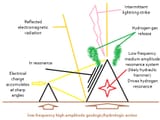Search Results
7/21/2025, 12:14:27 AM
>>937372607
Electrical engineers know that a conductor at a sharp angle produces a stronger magnetic field. Hence why a crimp in a headphone cable will produce a noisy signal and why right angles are avoided in circuit boards.
Consider how many pyramids are built on aquifers or springs. This not only provides a convenient water source but also produces stronger low frequency vibrations. This vibration is 'stepped up' by a resonant vibration in the pyramid itself, likely created by a hydraulic hammer that is also used in thermal management of chemical conversions taking place inside. If you fill angled interior passages with hydrogen gas in resonance you can start emitting microwaves. You then use nearby structures to amplify electromagnetic radiation via reflection. Their spacing at harmonic points means lower intensity is needed. The hot hydrogen gas escapes and rises, creating a tall plume of low resistance ionized air/hydrogen mixture. This is a carrier for the EM radiation. So you have high EM polarity, ionized gas, and also low amplitude waves in the air that all contribute to the effect.
The Giza complex is an obvious candidate because it seems to reflect the capabilities of the progenitors in its design but has been altered too drastically by later civilizations to have retained any of its original functional aspects.
We have to keep in mind these structures were multipurpose. This gets to the philosophy that guided these people and also makes their technology hard to identify. They utilized natural systems and avoided waste or environmental damage that we associate with industry and high technology.
Electrical engineers know that a conductor at a sharp angle produces a stronger magnetic field. Hence why a crimp in a headphone cable will produce a noisy signal and why right angles are avoided in circuit boards.
Consider how many pyramids are built on aquifers or springs. This not only provides a convenient water source but also produces stronger low frequency vibrations. This vibration is 'stepped up' by a resonant vibration in the pyramid itself, likely created by a hydraulic hammer that is also used in thermal management of chemical conversions taking place inside. If you fill angled interior passages with hydrogen gas in resonance you can start emitting microwaves. You then use nearby structures to amplify electromagnetic radiation via reflection. Their spacing at harmonic points means lower intensity is needed. The hot hydrogen gas escapes and rises, creating a tall plume of low resistance ionized air/hydrogen mixture. This is a carrier for the EM radiation. So you have high EM polarity, ionized gas, and also low amplitude waves in the air that all contribute to the effect.
The Giza complex is an obvious candidate because it seems to reflect the capabilities of the progenitors in its design but has been altered too drastically by later civilizations to have retained any of its original functional aspects.
We have to keep in mind these structures were multipurpose. This gets to the philosophy that guided these people and also makes their technology hard to identify. They utilized natural systems and avoided waste or environmental damage that we associate with industry and high technology.
Page 1
